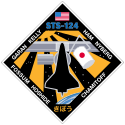Karen Nyberg
| Karen Nyberg | |
|---|---|
 | |
| NASA Astronaut | |
| Statsborger | USA |
| Nationalitet | Amerikaner |
| Status | Pensioneret |
| Født | 7. oktober 1969 Minnesota |
Andet arbejde | Maskiningeniør |
| Uddannelses- sted | University of Texas at Austin University of North Dakota |
| Rang | Ph.d. |
| Udvælgelse | NASA-gruppen fra 1998 |
| Mission(er) | NEEMO, STS-124, Soyuz TMA-09M (Expedition 36/37) |
| Missionsemblemer | |
Karen LuJean Nyberg (født 7. oktober 1969 i Minnesota) er en amerikansk maskiningeniør og ph.d., samt pensioneret NASA astronaut.
Nyberg blev den 50. kvinde i rummet på sin første mission i 2008. Indtil videre har hun deltaget i to rumfærge-missioner (STS-124), i 2008,
hvor hun var 1. missionsspecialist, samt Soyuz_TMA-09M, i 2013 hvor hun var flyvemaskinist (Flight engineer).
I alt har Karen tilbragt 180 dage i rummet.
Hun har tidligere opholdt sig i 2 uger i et undervandslaboratorium NEEMO i 2006, der minder om forholdene om bord på en rumstation.[1]
Karen Nyberg er maskiningeniør og ph.d., og hun har patent på “friendly” robot probe & socket.
Eksterne henvisninger
- Karen Nyberg – Biografi fra NASA (engelsk)
- STS 124 interview Arkiveret 17. maj 2008 hos Wayback Machine (engelsk)
Medier brugt på denne side
Official portrait photo of NASA astronaut Karen Nyberg, a mission specialist of STS-124.
Emblem of Nasa's STS-124 mission.
- The STS-124/1J patch depicts the Space Shuttle Discovery docked with the International Space Station (ISS). STS-124/1J is dedicated to delivering and installing the Japanese Experiment Module (JEM) known as Kibo (Hope) to the ISS. The significance of the mission and the Japanese contribution to the ISS is recognized by the Japanese flag depicted on the JEM Pressurized Module (JPM) and the word Kibo written in Japanese at the bottom of the patch. The view of the sun shining down upon the Earth represents the increased "hope" that the entire world will benefit from the JEM's scientific discoveries. The JPM will be the largest habitable module on the ISS and is equipped with its own airlock and robotic arm for external experiments. In addition to delivering and installing the JPM, the STS-124 crew will relocate the JEM Logistics Pressurized (JLP) module to its permanent home on the zenith side of the JPM. During three planned space walks, the crew will perform external ISS maintenance and JPM outfitting, as well as extensive robotic operations by the ISS, space shuttle, and JEM robotic arms. It will be the first time that three different robotic arms will be operated during a single space flight mission.
The dynamic design of the Expedition 36 patch portrays the International Space Station's (ISS) iconic solar arrays. The slanted angles denote a kinetic energy leading from the Earth in the lower right to the upper left tip of the triangular shape of the patch, representing the infinite scientific research, education, and long-duration spaceflight capabilities the ISS provides with each mission, as well as our goal for future exploration beyond the Space Station. The numbers 3 and 6 harmoniously intertwine to form expedition number 36 and its gray coloration signifies the unity and neutrality among all of the international partners of the ISS. The blue and gold color scheme of the patch represents the subtle way the central gold orbit wraps around the number 36 to form a trident at its lower right tip. The trident also symbolizes the sea, air, and land, all of which make up the Earth from where the trident originates in the design.
Leonardo da Vinci's Vitruvian Man, created some 525 years ago, as a blend of art and science and a symbol of the medical profession, is depicted amongst the orbits of a variety of satellites circling the Earth at great speed. Da Vinci's drawing, based on the proportions of man as described by the Roman architect Vitruvius, is often used as a symbol of symmetry of the human body and the universe as a whole. Almost perfect in symmetry as well, the International Space Station, with its solar wings spread out and illuminated by the first rays of dawn, is pictured as a mighty beacon arcing upwards across our night skies, the ultimate symbol of science and technology of our age. Six stars represent the six members of Expedition 37 crew, which includes two cosmonauts with a medical background, as well as a native of Da Vinci's Italy.




